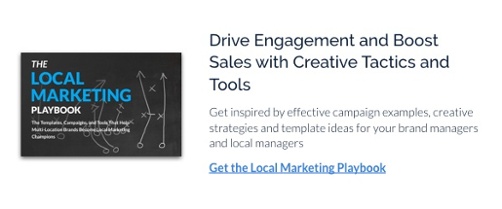For any corporate marketing team, improving the customer experience (CX) is a top priority in 2018. In fact, eConsultancy called CX the "most exciting opportunity" for 27 percent of enterprise organizations. When supporting a large, geographically diverse network of affiliates, brand managers know the value of advertising that has a local touch, especially as it relates to CX.
What is "localization" exactly? This phrase refers to the corporate brand's ability to adapt enterprise-level material for use in different local areas. When content is localized, the company's core values are communicated in a more relevant way through changes in messaging that are made to add a more localized flavor. Creative localization is more than just swapping one language for another or a "you guys" for a "y'all" here or there. Instead, it takes into account a broader range of variables including socioeconomics, politics, environment, colloquialisms, and more. According to a new study by the CMO Council, 49 percent of marketers say localized marketing is essential to growth.
However, identifying ways to inject the local mindset into the creative process comes with its own unique challenges. While the following list is by no means comprehensive, it's representative of some of the challenges headquarters faces when trying to execute creative localization:
- Brand managers don't understand the local customer. Truly effective localization begins with a real understanding of how consumer preference and habits change in different locations. Without some on-the-ground research, corporate marketing teams simply don't have what they need to initiate effective creative localization. Brand managers absolutely need to know who they're marketing to when localizing creative.
- Brand managers have difficulty balancing regional perspectives. Your suburban-market dealerships in the Midwest may have very different needs and priorities than dealerships in an East Coast city. Even though there's a lot of value in using design thinking when you face these problems—listening to unique, competing perspectives from all of your stakeholders—it's hard to capture all of this feedback and even harder to translate these wildly different perspectives into a coherent strategy for localized marketing.
- Brand managers can't read their local partners' minds. Your local affiliates almost certainly have some great ideas, but are they sharing them? Corporate marketers may get some insights from surveys and feedback forms, but they also need tools to connect local's ideas into real results. Some of the best feedback comes from watching what your highest-performing local affiliates are actually doing in the field and how it's driving a positive customer response. Without this valuable insight, brand managers may have some difficulties creating localized marketing material that truly resonates with the consumer.
While creative localization definitely presents a few unique challenges, leading multi-location brands are following certain techniques to deploy localized marketing more effectively.
Top Creative Localization Techniques for Brand Managers
While corporate marketing teams may never understand the mindset of their customers in Florida as intimately as their franchisees, efforts towards creative localization that start at headquarters matter. At the national level, creative localization efforts work to build confidence and trust with the consumer across the partner network. How then do the world's top enterprises guarantee that they're localizing creative effectively?
1. Create Tools to Understand the Local Landscape
Ideally, your corporate marketing team will uncover ways to strengthen the context of your localization efforts. Place is just one aspect of the customer's identity. Effective creative localization takes into account the entire buyer persona including age, language, goals, challenges and more. When localizing creative, it's important to layer in these unique factors. Is there any regional vocabulary or slang that the consumer frequently uses? Are there any specific values that they abide by? What are their shopping motives?
For example, McDonalds unveiled a series of advertisements in Bangkok. Featuring rich examples of nightlife in the city, customers are able to really identify and engage with an advertisement that understands the local landscape and the various activities that make it unique.
When brand managers understand that place is just one part of the locale, they can prepare marketing material that speaks directly to local priorities and culture. It's these nitty-gritty details that really make a difference when deploying truly localized marketing materials. And those details make all the difference in the world.
2. Create Event-Sensitive Local Advertising
In an advertising world that's increasingly trying to blend into what customers already engage with, it helps to keep your finger on the pulse of local events in your most popular markets and design creative that stays in tune with the local zeitgeist. Look for ways to create content that picks up on local events that can fuel a nice creative concept.
For example, Mercedes introduced an advertisement in the New York metropolitan area which paid tribute to the life of Yankees owner George Steinbrenner. Featuring Steinbrenner's iconic aviator sunglasses, sports fans in the area immediately recognized and identified with the advertisement. In a similar vein, New Balance's Nobody Runs Like Boston campaign celebrates the cities unique running culture and heritage.
With this approach, creative is laid out more authentically. Even better, with Local Marketing Automation (LMA) systems, brand managers can deliver concepts that are appropriate for specific locales without having to do lots of extra work. For the world's top enterprise brands, this means smarter marketing and more efficient workflows.
Better Response Rates: The Perfect Goal for Creative Localization
"Fostering a deeper bond with the consumer so that they perceive the brand as a 'brand for me' is essential in gaining a consumer commitment to your brand," argues Marla Tabaka in Entrepreneur.
Oftentimes, consumers make purchasing decisions based on how the brand makes them feel. When a thoughtfully-executed piece of localized marketing is put in front of them, the consumer feels valued and respected. The brand proves that it can be relevant to the language, cultural identity, and other various nuances that make that locale unique and special. Creative localization allows businesses to pinpoint their marketing messages in a way that truly identifies with and complements the local landscape. Consumers are grabbed by these ads and they're more likely to interact with the brand since they know the brand just "gets it."
To measure creative localization effectiveness, consider running a split test. How did one particular localized advertisement compare to a non-localized counterpart? Evaluate each ad's time in the market and how sales performed during those times. If the localized advertisement shows an increased response rate, consider deploying a similar approach in other markets or contexts.
What's at stake if brands fail at creative localization? In one of the most famous examples of creative localization gone wrong, Pepsi unveiled its "Pepsi Brings You Back to Life" slogan in Chinese markets, which, when translated into the local dialect, reads "Pepsi Brings You Back from the Grave." In a country that worships and celebrates the lives of its ancestors, this was a serious misstep by the popular beverage manufacturer.
How to Support Creative Localization at Scale
For many distributed brands, creative localization is a shared effort. Ultimately, the precise balance of local marketer versus corporate responsibility depends on the culture and structure of the brand. Do your local affiliates want you to create marketing materials for them or are they interested in shouldering some of that effort?
Unfortunately, headquarters rarely have the time or resources to help each of their local affiliates customize and localize their own creative. One-off requests to create direct mail campaigns for a single storefront can quickly consume design resources, making it difficult to deliver on next quarter's strategy. User-friendly LMA software can significantly reduce the burden on corporate marketing teams by making it easy for local affiliates to use existing marketing templates that have been prepared in advance. When local affiliates no longer email corporate marketers asking for files and new designs, national teams can earn back the time needed to develop effective and engaging localized campaigns.






